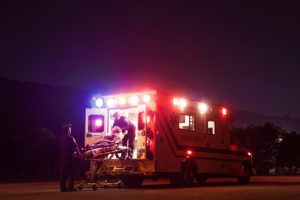Since 2000, mass shootings (>3 deaths) have increased in frequency and severity. Hemorrhage is the main cause of death immediately following gun shoot wounds, and survival of these patients depends on stopping the bleeding using tourniquets and expedient transfusion of blood components. Retrospective data collected after the October 2017 mass shooting in Las Vegas, Nevada, which killed 58 and injured more than 600, indicated that the available blood supply was adequate for the wounded patients. After the Las Vegas shooting, almost 500 blood products were transfused to 220 hospitalized patients (68 in critical care) during the first 24 hours in a RBC: plasma: platelet ratio of 1:0.54:0.81. United Blood Services (now Vitalant) and the American Red Cross provided Las Vegas hospitals an additional 700 blood products to replace units that had been used within the first 14 hours after the shooting. Calls for donations from well-meaning agencies led to 791 blood donations immediately following the shooting of which 137 (17.3%) were wasted. Maintaining adequate supplies of blood from routine donations and training in hemorrhage control may help communities prepare for future mass shootings.
Reference:

